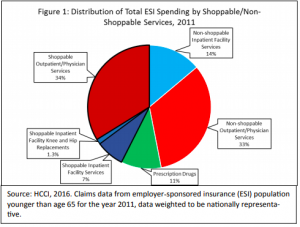Yesterday’s executive order by President Trump requires HHS to develop regulations requiring healthcare providers and insurers to publicly post the prices paid for healthcare.
According to Trump, this is “a giant step towards a heath care system that is really fantastic.”
Let’s talk about what this means for you.
First, there’s enough wiggle room in the order to make the slinkiest of snakes comfortable. For example, there are no specific requirements about what information doctors, hospitals and insurers have to disclose.
Second, the executive order itself has no force of law.
Third, if prices are ever posted, patients won’t know what they – the patient – have to pay. The order discusses posting what insurance companies have agreed to pay for a procedure – not what the patient owes.
Fourth, there’s no conclusive research finding that publishing prices reduces overall cost – or even affects consumer behavior. But there is research indicating patients don’t use data to find lower cost care.
Fourth-and-a-half, despite what the President claims in his Executive Order most healthcare services aren’t “shoppable”. If your spouse has chest pain, you aren’t going to wade thru some government database to find the lowest cost heart surgeon. Plus, you aren’t walking in with a shopping list of specific procedures – you’ll get the procedures your doctor orders, and you won’t be in any position to go to one hospital for an MRI and another for anesthesia.

I see you want an MRI, an appendectomy, one assistant surgeon, 2 units of blood, and 5 visits from random doctors.
Want proof?…about one healthcare dollar out of twelve is spent by patients on shoppable services.

Fifth, pricing agreements are proprietary, negotiated between insurers and providers. Both are now arguing that publicly disclosing those private, confidential contracts will result in higher prices as providers – who now have pricing power over insurers in many markets – find out how much their rivals are getting paid.
Sixth, credible research shows that prices increase when suppliers and buyers have to disclose prices. From the NYT:
The Danish government, in an effort to improve competition in the early 1990s, required manufacturers of ready-mix concrete to disclose their negotiated prices with their customers. Prices for the product then rose 15 percent to 20 percent.
The reason, scholars concluded, is that there were few manufacturers competing for business. Once companies knew what their competitors were charging, it was easy for them to all raise their prices in concert. They could collude without the sort of direct communication that would make such behavior illegal.
Seventh, most healthcare spending is for patients with multiple chronic, and expensive, health conditions. Think high blood pressure, asthma, depression, diabetes, cardiovascular disease. These folks blow thru their deductible in March. After that, their healthcare is free to them, so they don’t care what the cost is.
Eighth, any regulations will take years to develop, and will be subject to endless lawsuits. Too bad the attorneys don’t have to post their prices…
What does this mean for you?
This is political grandstanding and will have zero impact on healthcare costs – or what you pay for insurance premiums.
But is sure is easier than actually doing something to improve our healthcare system and lower your costs.
Spoiler Alert – Oh, and the Executive Order adds a whole new layer of bureaucracy and reporting requirements, which will increase healthcare administrative expenses.



You’re obviously anti-Trump or anti-Republican or both. This is opinion piece is nothing more than anti-Trump grandstanding. Where is your objectivity? Had this been an Obama executive order, you would have gone out of your way to find reasons to sing its praise. Shameful!
Hello Randal and welcome to MCM. Always good to hear from my friends at Liberty Mutual.
Thanks for the comment. It would be helpful if you would provide the specific concerns you have with my post. Which facts did I get wrong, and why. Providing citations to back up any assertions – as I do – is also welcomed.
Another point- if you believe this executive order is in fact useful, please provide the logic and citations to support that assertion.
I look forward to your response
cheers Joe
Randal has it right……………Personally, I think it could be helpful, not in every situation, but when shopping for doctors and primary and specialists for instance, when you haven’t reached your deductible yet, it could matter. The medical and physician pricing is all over the place. Healthcare is a commodity and the only commodity we purchase without knowing what it is going to cost us when we walk through the door.
Hi Sharon and welcome to MCM. Thanks for the comment.
I’d appreciate it if you could clarify how Randal has it right. I provide citations and back-up research, he opines that I’m biased. I’m not sure why he says that; facts are facts and aren’t biased.
Also, you may want to take another look at the pie chart. It clearly indicates relatively few healthcare dollars are spent on “shoppable” services. As in one out of 12. That being the case, I don’t see how Pres Trump’s claim that this “transparency” initiative could be bigger than healthcare, and that it will reduce costs is supportable. If you have insights please share.
cheers Joe
From Les Shute via email –
Opacity in HC = higher spending
Transparency in HC = higher spending (see “concrete” evidence) and higher admin costs
Conclusion = attempts to treat healthcare like any other market will fail because it isn’t shopable and even if it was look at what happened to Danish concrete.
Danish concrete…really? Poor example by the NYT, BTW, as the spike occurred in 1992 yet the price dropped back down to below 1991 levels as of 1995…tethered by lower priced international competition.
image1.jpeg
As an alternative to the HC price transparency argument, perhaps we should just skip ahead and tie future HC spending increases to the DCI (Danish Concrete Index). :-)”
Joe, you alluded to something here and it might need another entire article to make the point. Besides the politics, the only party that stands to win from this executive order are the lawyers.
I disagree with the idea that posting prices will have little effect on expense and quality of care. Although a high percentage of healthcare dollars are spent managing chronic disease there is an equally large sum of money spent on common, short length of stay or out patient surgery. There is sufficient evidence that posting prices as a bundle has a positive effect on both quality and cost savings. This model has been successful for years at the Oklahoma Surgery Center.
The amount of money that could be saved by the self insured businesses is staggering. Hospitals and insurance companies are the only winners in the current system. Patients, self insured businesses and physicians are all on the losing end of the current situation. This issue is non-partisan , effects everyone and in time will implode healthcare.
I have been posting my prices for various abdominal surgeries for years on my website. The cost of care is shrouded for a purpose. For the majority of commonly performed procedures a price can be set and provided. Why the public hasn’t demanded more clarity is shocking. It’s time for transparent care. The free market has been proven in every industry. Time to let it work it’s magic in medicine.
Hello Scott – thanks for the comment and welcome.
I’m curious as to what research indicates posting prices will affect consumer behavior in healthcare. I haven’t seen much that attests to that. Please provide any backup – thanks
I’d note that w’re talking two different “buyers” here – corporate ones who select vendors for a network of surgical centers (for example) and individual consumers who are much more focused on how much the procedure will cost them – i.e. is it in network and what’s their cost share.